Rolling Resistance Comparison of Tubeless Vs Tubed Fat Bike Tires
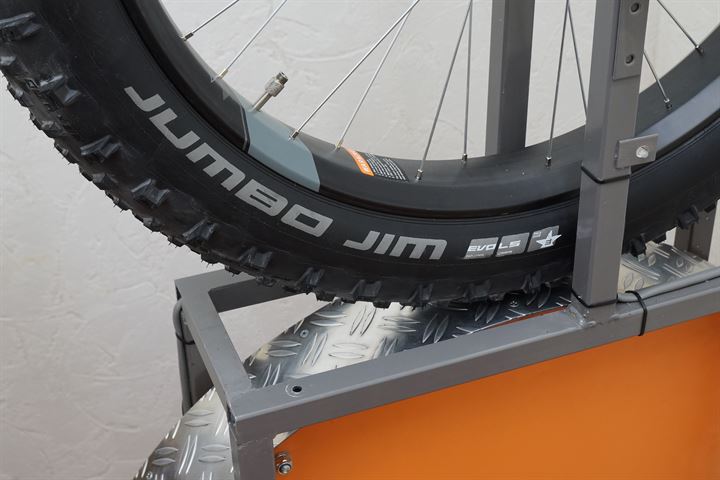
After the launch of the fat bike section, I've received a lot of requests to do a fat bike tubeless Vs inner tubes test just like the MTB tubeless Vs latex Vs butyl tubes test. This article is similar to the MTB article except for the exclusion of a latex inner tube as that doesn't seem to be available for fat bikes. The MTB tubeless article proved that converting to tubeless resulted in a much lower rolling resistance at low air pressures. With the use of ultra-low air pressures in fat bike tires, converting to tubeless could be even more useful.
The MTB tubeless test was performed with just a single tire which resulted in a lot of people asking me to complete the same tests with other tires to see if the results would vary with the use of different tires. That's why I've performed tests with three different fat bike tires (Schwalbe Jumbo Jim LiteSkin, Specialized Fast Trak Fat, 45NRTH Van Helga) right from the start. This article will show the difference in rolling resistance between a tubeless fat bike set up with 60 ml sealant and a 390 grams Schwalbe SV13J butyl inner tube.
To make this test even more interesting, I've also included 6 psi / 0.4 bars data as the 8 psi / 0.55 bars of the regular tests might still be a bit too high for a test like this. I've tried to run tests at 4 psi / 0.28 bars as well, but my rolling resistance machine just isn't powerful enough to spin the tires up to speed at that low of an air pressure.
Test set up
All test conditions were the same with the same wheel, tire, load, and speed used. With the only difference being the utilization of a 390 grams Schwalbe SV13J fat bike inner tube for the "tubed" results and no inner tube for the "tubeless" results. I did use 60 ml of tubeless sealant when mounting the tire tubeless.
Test conditions
- Speed of 18 mph / 29 km/h
- Total wheel load of 94 lbs/ 42.5 kg
- Temperature 22 °C / 71 °F
- Rolling Resistance Test Conditions Explained
Butyl inner tube set up
- Inner tube: 390 grams Schwalbe SV13J
- Rim: Whisky No 9, 65 mm inner width
Tubeless set up
- Sealant: 60 ml tubeless sealant
- Rim: Whisky No 9, 65 mm inner width
Tested tires
- Schwalbe Jumbo Jim LiteSkin 26 x 4.00
- Specialized Fast Trak Fat 26 x 4.00
- 45NRTH Van Helga 26 x 4.00
Test Results
Total Weight
There is a definite weight advantage for the tubeless set up as I've used a true tubeless rim that only needs a 10 grams tubeless valve to seal the tire/rim. Depending on the amount of sealant used in the tubeless set up and the weight of the inner tube, the weight advantage of the tubeless set up will be somewhere between 300 - 500 grams per wheel.
For this particular test, the weight advantage of the tubeless set up comes down to 320 grams (60 grams sealant + 10 grams tubeless valve Vs 390 grams inner tube).
| Tubeless | 390 gr Inner Tube | |
|---|---|---|
| Total Wheel Weight Excluding Tire | 1110 grams | 1430 grams |
Rolling Resistance
As expected, rolling resistance goes down when eliminating the inner tube. Also, The lower the air pressure, the bigger the advantage of the tubeless set up gets. When looking at the averages of the three tires tested, the consensus seems to be that at the high air pressure of 20 psi / 1.4 bars, rolling resistance is close to 4 watts lower. At the very low air pressure of 6 psi / 0.4 bars, the advantage of the tubeless set up is close to 10 watts per tire.
The tubeless advantage turned out to be pretty equal along the three different tires tested, I feel the average between these tires will be very useful to give a rough indication of how much can be gained when converting from inner tubes to tubeless. See all graphs below to get a clear idea of how much can be gained depending on the air pressure used. Scroll down a bit further to see the per tire breakdown of the test results.
One more thing to note is the inner tube used for these tests is already a bit of a "light" butyl inner tube although Schwalbe doesn't specify it as a light tube. Most other fat bike inner tubes seem to come in closer to 500 grams instead of the 390 grams of the Schwalbe SV13J. When using a heavier tube than the 390 grams Schwalbe, the advantage of the tubeless set up will be even bigger.
| Average Tubeless Advantage of 3 Fat Bike Tires | |||
|---|---|---|---|
| Tubeless | Inner Tube | Advantage | |
| Rolling Resistance 20 psi / 1.4 Bar | 23.6 Watts | 27.7 Watts | 4.1 Watts |
| Rolling Resistance 16 psi / 1.1 Bar | 25.6 Watts | 29.8 Watts | 4.2 Watts |
| Rolling Resistance 12 psi / 0.8 Bar | 29.1 Watts | 34.6 Watts | 5.5 Watts |
| Rolling Resistance 8 psi / 0.55 Bar | 36.3 Watts | 43.8 Watts | 7.5 Watts |
| Rolling Resistance 6 psi / 0.4 Bar | 44.8 Watts | 54.2 Watts | 9.4 Watts |
| CRR 20 psi / 1.4 Bar | 0.00707 | 0.00830 | 0.00123 |
| CRR 16 psi / 1.1 Bar | 0.00767 | 0.00893 | 0.00126 |
| CRR 12 psi / 0.8 Bar | 0.00872 | 0.01037 | 0.00165 |
| CRR 8 psi / 0.55 Bar | 0.01088 | 0.01313 | 0.00225 |
| CRR 6 psi / 0.4 Bar | 0.01343 | 0.01625 | 0.00282 |
Detailed Results of the 3 Tires Tested
Schwalbe Jumbo Jim LiteSkin 26 x 4.00
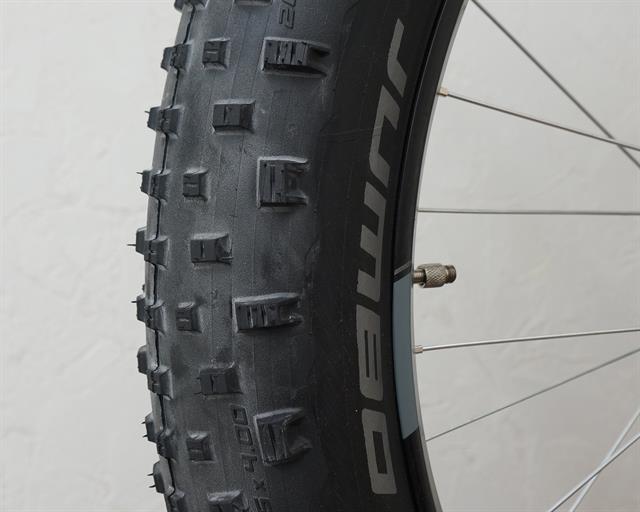
The Schwalbe Jumbo Jim LiteSkin (read review) is simply the fastest fat bike tire I've tested up to now. When looking a the 6 psi / 0.4 bars results, the advantage the Jumbo Jims has over the competition only grows bigger. This tire should still feel quite fast at 6 psi when used tubeless on asphalt roads. Some smaller 29 x 2.25 MTB tires even have a higher rolling resistance than the tubeless Jumbo Jim LiteSkin which is just crazy.
| Schwalbe Jumbo Jim LiteSkin 26 x 4.00 | |||
|---|---|---|---|
| Tubeless | Inner Tube | Advantage | |
| Rolling Resistance 20 psi / 1.4 Bar | 19 Watts | 23.3 Watts | 4.3 Watts |
| Rolling Resistance 16 psi / 1.1 Bar | 20.5 Watts | 24.7 Watts | 4.2 Watts |
| Rolling Resistance 12 psi / 0.8 Bar | 23.6 Watts | 28.7 Watts | 5.1 Watts |
| Rolling Resistance 8 psi / 0.55 Bar | 29.6 Watts | 36.9 Watts | 7.3 Watts |
| Rolling Resistance 6 psi / 0.4 Bar | 36.7 Watts | 46.4 Watts | 9.7 Watts |
| CRR 20 psi / 1.4 Bar | 0.00570 | 0.00698 | 0.00128 |
| CRR 16 psi / 1.1 Bar | 0.00615 | 0.00740 | 0.00125 |
| CRR 12 psi / 0.8 Bar | 0.00707 | 0.00860 | 0.00153 |
| CRR 8 psi / 0.55 Bar | 0.00887 | 0.01106 | 0.00219 |
| CRR 6 psi / 0.4 Bar | 0.01100 | 0.01391 | 0.00291 |
Specialized Fast Trak Fat 26 x 4.00
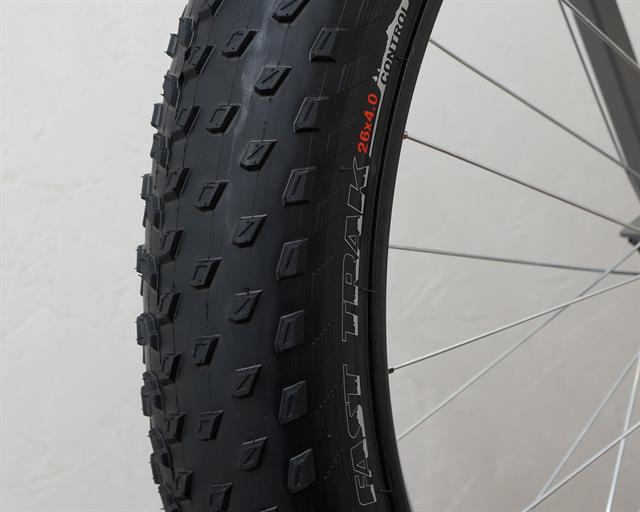
The Specialized Fast Trak Fat (read review) comes in a bit slower when compared to the Jumbo Jim LiteSkin. Dropping the air pressure to 6 psi / 0.55 psi results in a rolling resistance of 45.1 Watts which is quite a bit more than the 36.7 watts of the Jumbo Jim. The Fast Trak Fast does have much thicker sidewalls (1.8 mm Vs 0.55 mm of the Jumbo Jim) which should make this tire much more resistant to cuts and easier to seal when used tubeless.
| Specialized Fast Trak Fat 26 x 4.00 | |||
|---|---|---|---|
| Tubeless | Inner Tube | Advantage | |
| Rolling Resistance 20 psi / 1.4 Bar | 22.2 Watts | 26 Watts | 3.8 Watts |
| Rolling Resistance 16 psi / 1.1 Bar | 25 Watts | 28.7 Watts | 3.7 Watts |
| Rolling Resistance 12 psi / 0.8 Bar | 28.7 Watts | 34.1 Watts | 5.4 Watts |
| Rolling Resistance 8 psi / 0.55 Bar | 36.5 Watts | 43.4 Watts | 6.9 Watts |
| Rolling Resistance 6 psi / 0.4 Bar | 45.1 Watts | 54 Watts | 8.9 Watts |
| CRR 20 psi / 1.4 Bar | 0.00665 | 0.00779 | 0.00114 |
| CRR 16 psi / 1.1 Bar | 0.00749 | 0.00860 | 0.00111 |
| CRR 12 psi / 0.8 Bar | 0.00860 | 0.01022 | 0.00162 |
| CRR 8 psi / 0.55 Bar | 0.01094 | 0.01300 | 0.00207 |
| CRR 6 psi / 0.4 Bar | 0.01352 | 0.01619 | 0.00267 |
45NRTH Van Helga 26 x 4.00
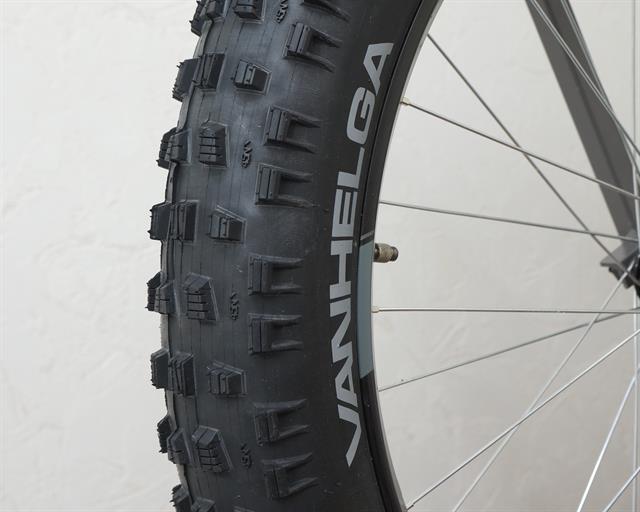
The 45NRTH Van Helga (read review) is a tire that comes with huge knobs made to dig in and provide lots of grip. Even though this is clearly a different tire than the Schwalbe and Specialized, the difference between running the Van Helga with an inner tube or tubeless comes in pretty close to the other tires. With the results of these three tires, I feel it's safe to assume that any other 26 x 4.00 fat bike tire will show the same gain when dropping the inner tube and converting to tubeless.
| 45NRTH Van Helga 26 x 4.00 | |||
|---|---|---|---|
| Tubeless | Inner Tube | Advantage | |
| Rolling Resistance 20 psi / 1.4 Bar | 29.6 Watts | 33.8 Watts | 4.2 Watts |
| Rolling Resistance 16 psi / 1.1 Bar | 31.4 Watts | 36.1 Watts | 4.7 Watts |
| Rolling Resistance 12 psi / 0.8 Bar | 34.9 Watts | 41.0 Watts | 6.1 Watts |
| Rolling Resistance 8 psi / 0.55 Bar | 42.7 Watts | 51.0 Watts | 8.3 Watts |
| Rolling Resistance 6 psi / 0.4 Bar | 52.6 Watts | 62.1 Watts | 9.5 Watts |
| CRR 20 psi / 1.4 Bar | 0.00887 | 0.01013 | 0.00126 |
| CRR 16 psi / 1.1 Bar | 0.00941 | 0.01082 | 0.00141 |
| CRR 12 psi / 0.8 Bar | 0.01046 | 0.01229 | 0.00183 |
| CRR 8 psi / 0.55 Bar | 0.01280 | 0.01529 | 0.00249 |
| CRR 6 psi / 0.4 Bar | 0.01577 | 0.01862 | 0.00285 |
Conclusion
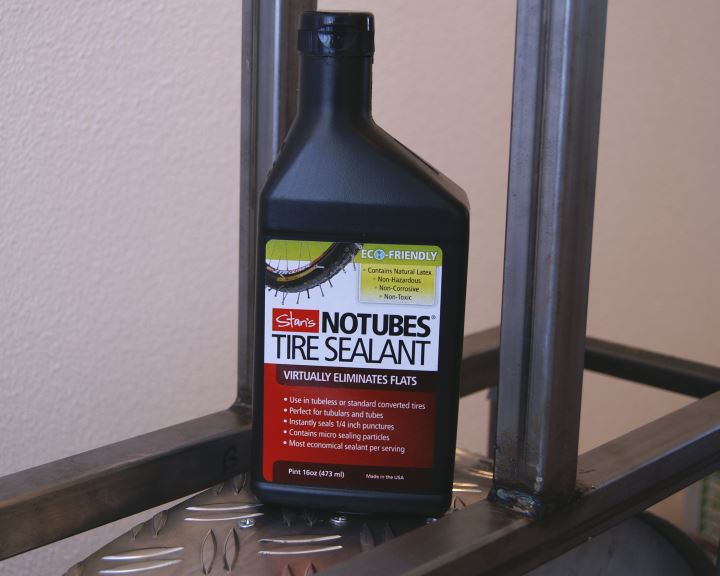
In my opinion, tubeless is a necessity on fat bikes if you value speed. Simply taking out the inner tube will save you 15 watts for a pair of tires at an air pressure of 8 psi / 0.55 bars. When you ride at even lower air pressures like 6 psi / 0.4 bars, you end up wasting 20 watts of valuable power in the tires. When you consider that an average cyclist power output will be somewhere around 200 - 250 Watts, it means you could gain an extra 10% of usable power quite easily.
Although I wasn't able to test at air pressures of less than 6 psi, it's obvious from looking at the test results that running even lower pressures (4-5 psi) means inner tube losses will quickly rise to 30 watts for a pair of tires. Remember the softer the surface, the lower the air pressure you should run to avoid digging into the surface too much. When running these kinds of low air pressures, using inner tubes would be crazy.
